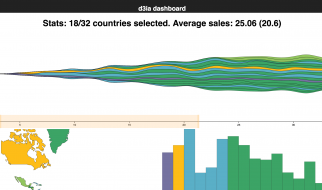 Valerie Plame photographed in her home in Santa Fe, New Mexico. Photos: Benjamin Rasmussen
Valerie Plame photographed in her home in Santa Fe, New Mexico. Photos: Benjamin Rasmussen
Valerie Plame worked for the CIA and tangled with Bush. Now she wants to fight Trump from Congress.

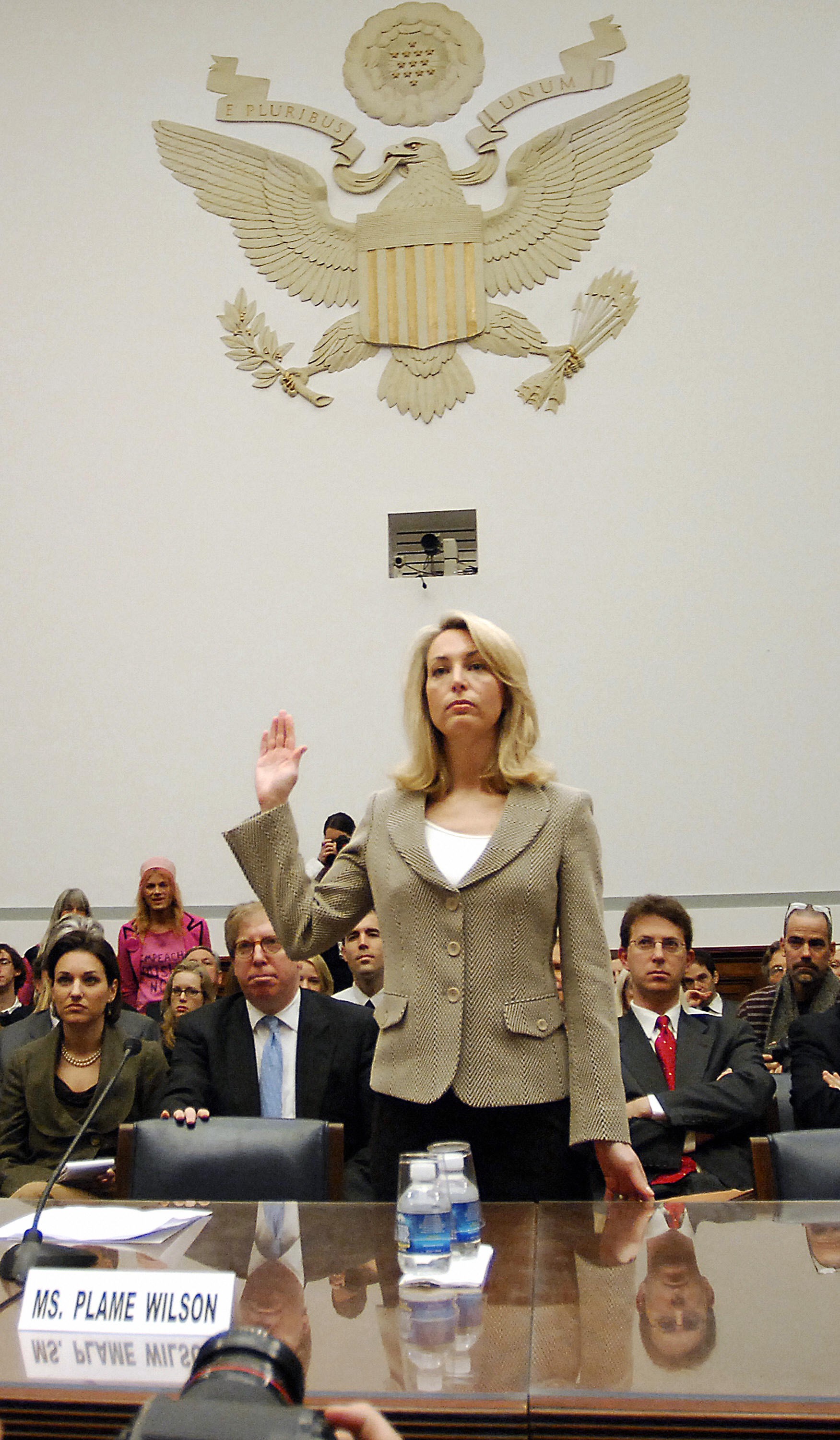 Valerie Plame Wilson and her husband Joe Wilson in 2006. Plame is sworn in before testifying before the U.S. House of Representatives in 2007. Photo: Chip Somodevilla/Getty Images; Mannie Garcia/AFP, via Getty Images.
Valerie Plame Wilson and her husband Joe Wilson in 2006. Plame is sworn in before testifying before the U.S. House of Representatives in 2007. Photo: Chip Somodevilla/Getty Images; Mannie Garcia/AFP, via Getty Images.
After the Supreme Court declined to hear her lawsuit against Bush officials, Plame and her husband, the retired ambassador Joseph Wilson, left D.C. and moved to New Mexico. The rest of the world eventually moved on from Iraq ? except of course, that it didn?t. The Iraq War left the field open for ISIS, prompted the waves of migration out of the Middle East that arguably spawned Brexit and the xenophobic Trumpworld we live in today.
Plame?s celebrity ? Naomi Watts played her in a 2010 biopic ? has meant money and unearned media for her as a congressional candidate. She doesn?t have to do much to get attention. The Washington Post profiled her run, and her announcement ad ? the badass agent driving backward in the desert at 60 miles an hour ? went viral.
But that might not be the kind of attention that wins the State of Enchantment. New Mexico is a beautiful but poor state. It consistently shows up in the bottom five in rankings of states by fiscal condition. It never rebounded from the 2008 recession. Its residents are more concerned with the fact they have to drive hundreds of miles to a hospital or with the economy and jobs than Trump?s impeachment, or whatever happened in Iraq ages ago. It is also a military state with two national weapons labs and an Air Force base integral to the national nuclear weapons complex.
The hamlets that dot the high desert in New Mexico?s Third District announce themselves with road signs that always include elevations and pop. ? the first number high, the latter, usually very low. The scrub-brush vastness is sparsely populated by the well-to-do descendants of land-grant Hispanics; impoverished Pueblo tribes, many living in trailer homes with dirt yards; plus a population of highly paid, mostly white federal bureaucrats ? nuclear weapons engineers and physicists and computer researchers ? at the national labs. The tribes own immense tracts of land, but have limited their development to the occasional casino. The largest private landowners in the state are either out of state billionaires or family dynasties whose rights date back centuries. Superrich outsiders play cowboy in studded deerskin boots and turquoise, flying in and out of gentlemen?s ranches on private jets. (Jeffrey Epstein?s Zorro Ranch was out this way). About the only thing all the constituents ? 36% Hispanic, almost 20% Native and 41% white ? of New Mexico?s Third congressional district have in common is a shared concern about water rights.
What Plame has in money and fame, she lacks in local constituency and party support.
For the past dozen years, Rep. Ben Ray Lujn, a rising star who has chaired the Democrat?s congressional reelection committee, held the seat. Now he is running for the U.S. Senate. The seat he?s vacating has been held by a Democrat, except for two years, ever since it was created in 1983. Whoever wins the primary in June likely wins the ticket to Washington in November. The field is crowded: besides Plame, candidates include Stanford-educated, Spanish-speaking Santa Fe lawyer Teresa Leger Fernandez, a district native; Santa Fe district attorney Marco Serna; Sandoval County treasurer Laura Montoya; environmental attorney Kyle Tisdel of Taos; former deputy New Mexico Secretary of State John Blair and at least seven others.
The primary field is so crowded, the winner could get nominated with less than 20% of the vote, and maybe as little as 12%.
 A poster for Fair Game, the film based on Valerie Plame?s experiences, in her garage in Santa Fe.
A poster for Fair Game, the film based on Valerie Plame?s experiences, in her garage in Santa Fe.
Plame has a vast lead in national name recognition, and therefore, fundraising ? more than $2 million as of the last fundraising quarter. That?s $800,000 more than Fernandez and $1.3 million more than Serna pulled in. Her biggest donors are not New Mexicans, but vulture capitalists from Bain Capital, followed by L.A.-based Warner Brothers. Meanwhile, Leger Fernandez?s biggest donor is a boots-on-the-ground enterprise linked to traditional New Mexico networks ? the Committee for Hispanic Causes? BOLD PAC.
What Plame has in money and fame, she lacks in local constituency and party support. Plame?s contrarian political instincts ? aligning herself with many of the goals of the Alexandra Ocasio-Cortez edge of the Democratic party, critical of Israeli influence on American politics, outspoken critic of nuclear defense industrial expansion, and in league with atheist skeptics ? might have made her a little too radioactive for the national Democratic political establishment. Emily?s List, a major seed funding source for Democratic women in politics, chose to ignore her and back Leger Fernandez. Another clue that national Democrats prefer Leger Fernandez: Employees of the Hillary Clinton-connected national strategy firm PSB Research are among Leger Fernandez?s top donors.
Plame?s nationwide celebrity and money don?t mean as much in the tiny state Democratic Party apparatus. She finished fifth out of six, winning only 5% of 400 votes, in a pre-primary delegate contest held in March. Leger Fernandez won with 41.9% of the delegate vote. Plame?s delegate haul was even far below the threshold of 20% that would have automatically qualified her for the ballot in the June primary. But her team of paid staff and unpaid volunteers at shopping malls and street corners brought in the requisite signatures.
?I?m not a political insider and that whole convention is built around that,? she said after the loss. ?Our strategy hasn?t changed one bit. The convention is very much a political insiders? game ? that I am not.?
But Santa Fe New Mexican political columnist Milan Simonich thought the results were more significant than she wanted to concede. ?I don?t see any momentum now for anyone other than Leger Fernandez,? he said. ?It looks like hers to lose.? In the weeks before the election, he said Plame had made a bit of a comeback, but he still predicted Leger Fernandez would walk away the victor: ?Plame is the only candidate who could beat Leger Fernandez, but I?m not betting on an upset. I expect Leger Fernandez to win based on a faster start. That was more important than ever because of the novel coronavirus pandemic.?
A late May Emily?s List poll gave Fernandez a nine-point lead. Plame believes her internal poll numbers, from the national Democratic pollster Anzalone Liszt Grove Research, show a different trajectory, and her campaign manager said the campaign is still optimistic. ?We know that vote-by-mail has engaged a new universe of voters who haven?t voted in primaries yet, so we will rely on the only poll that matters: election day,? Michelle Barliant told me.
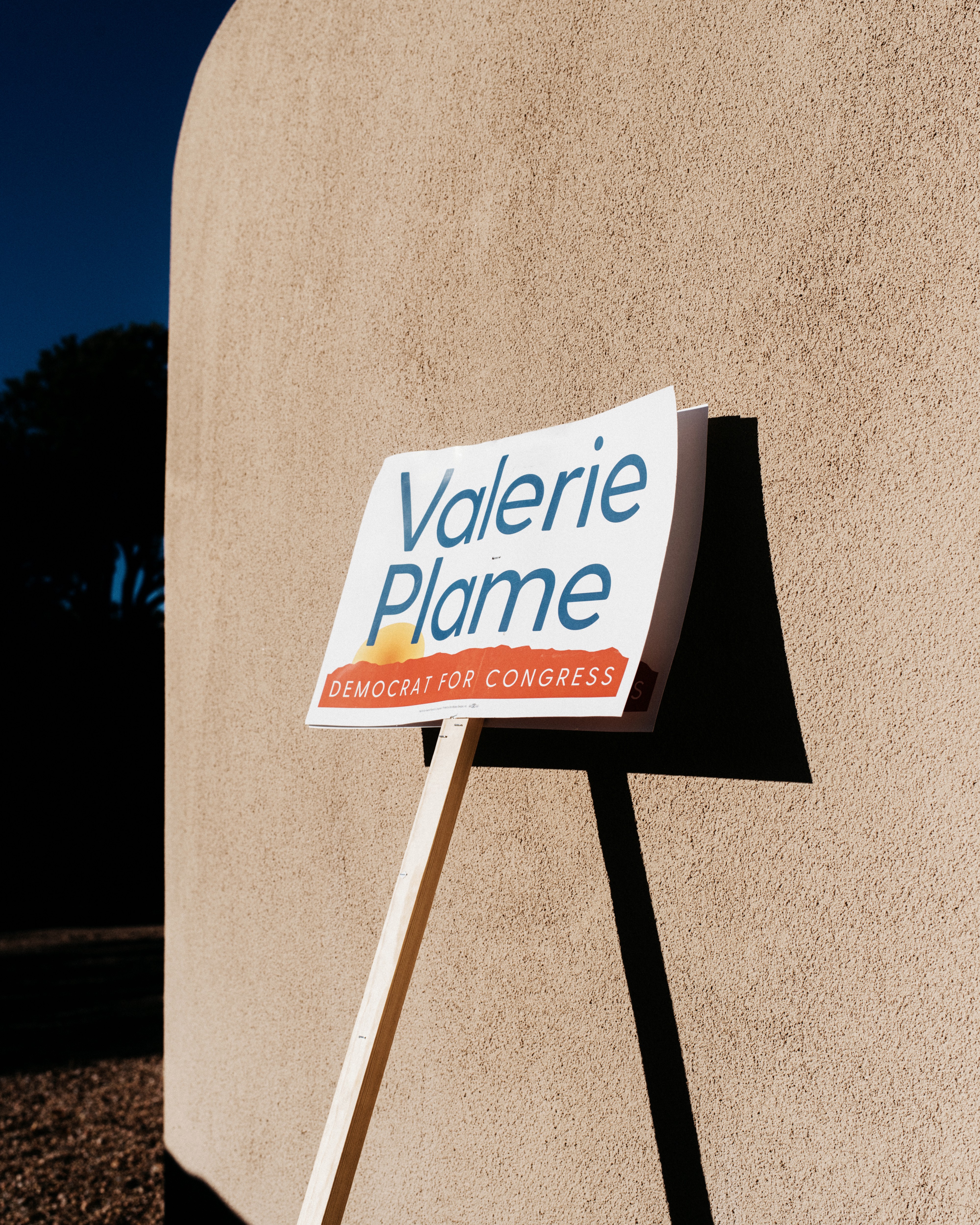 A campaign sign outside Valerie Plame?s home in Santa Fe.
A campaign sign outside Valerie Plame?s home in Santa Fe.
The ex-spy?s learning curve on her way to Tuesday?s primary has been steep. Some of her advisors worried that she came across as too cool to connect with voters, who value more warmth in female candidates especially. Plame?s approach to politics initially was to leverage her high profile while maintaining secret-agent diffidence, and indulging her rebel streak when it comes to the political establishment. She started her campaign and ran it for months with a manager, Barliant, drafted from her circle of suburban mom-friends. She eventually brought on a seasoned campaign manager, Alex Koren, whose resume includes Silicon Valley startups and various House races. (He left the campaign after a few months and Barliant has stepped back in.) Plame?s money also afforded her a major national media strategist, Mark Putnam, who has worked for other New Mexico candidates. Putnam gets credit for the viral first campaign ad showcasing Plame from above driving backwards through the desert at 70 miles per hour ? a visual metaphor for the voice-over that Trump is setting the nation back, while Plame wants to take it forward. Plus it just looked cool.
The morning air is thin, dry and scented with sage as Plame exits her 6,000-square-foot house in the exurbs above Santa Fe. With the kids gone to college and her widowed status ? Wilson passed away in September ? she wants to sell this Western manse with its fort-size fireplace, all white plaster and tiled flooring, filled with Mission furniture, black-and-white Ansel Adams Western photography, and books and mementos from a lifetime of travels. Dressed in hiking clothes, carrying a large breakfast smoothie, she slips behind the wheel of her gray SUV and steers north through the Pojoaque Valley, heading north for listening sessions with politicos up in Los Alamos.
Beyond the posh exurbs, billboards every few miles urge drivers to call in anonymous tips about reservation crime. Unreported crime plagues the local Native American reservations. Plame has donated some of her celebrity to fundraising for the victims of unreported domestic violence, women and children who have disappeared over the years in the thousands on reservations around the U.S.
Plame discovered and fell in love with New Mexico in the course of her covert work at the CIA?s division of counterproliferation before and after 9/11. She joined the CIA out of Penn State in 1985 and was such a star that she was one of just three trainees in a CIA training class of 50 to be hired as a nonofficial cover officer, the most clandestine of the CIA?s agents.
After a stint in Greece, she was assigned to track nuclear materials, and began making regular trips to Los Alamos to confer with nuclear weapons engineers and physicists. After 9/11, Plame?s unit covertly reached out to Iraqi scientists through family members and friends, and the scientists insisted there were no weapons of mass destruction, or WMD. Bush, itching for war with Iraq, preferred a different story, and in his State of the Union address in 2002, claimed that Iraq had acquired nuclear materials from Niger. This was news to the CIA. In late February 2002, the agency (in a move that didn?t involve Plame) sent Plame?s husband to Niger to find out whether Saddam Hussein was indeed buying ?yellowcake uranium.? Wilson reported back that there was no evidence. Colin Powell used the disproved yellowcake allegation anyway in an address to the United Nations that aired worldwide just before the U.S. attacked Iraq.
Watching the U.S. bombing of Baghdad on television on March 20, 2003, Plame would recall in her book: ?I felt that we had failed miserably. It was a disaster in the making.?
Three months into the Iraq War, with the administration still lying about WMD, Wilson could take it no longer. The New York Times published his op-ed, ?What I Didn?t Find in Africa.? And the Bush White House avenged itself by outing Plame.
The couple was red meat for right-wing media. But that was only the beginning. The IRS audited them in 2004. Plame developed chronic digestive problems, and became ?wary, jumpy, frightened ? out of character for me.? The couple?s relationship suffered. They were spooked by a strange incident in which bolts that supported the upper floor of their deck mysteriously disappeared; had the missing bolts not been noticed, the deck could have collapsed and killed someone. Libby?s conviction brought them little relief. The disastrous war was well underway and would continue for more than a decade. Their Washington lives were over.
Plame didn?t think about entering politics when she moved to New Mexico in 2006, she just wanted her kids ? fraternal twins born in 2000 ? to have a normal life with financially stable, relaxed parents. She wrote a memoir which became a movie, and then co-wrote two well-received spy novels. She didn?t exactly shy away from her role as progressive hero: She and Wilson had first visited Santa Fe together in September 2006 to help raise money for an outfit called the Military Religious Freedom Foundation, a skeptic?s group which fights against religious proselytizing in the U.S. military.
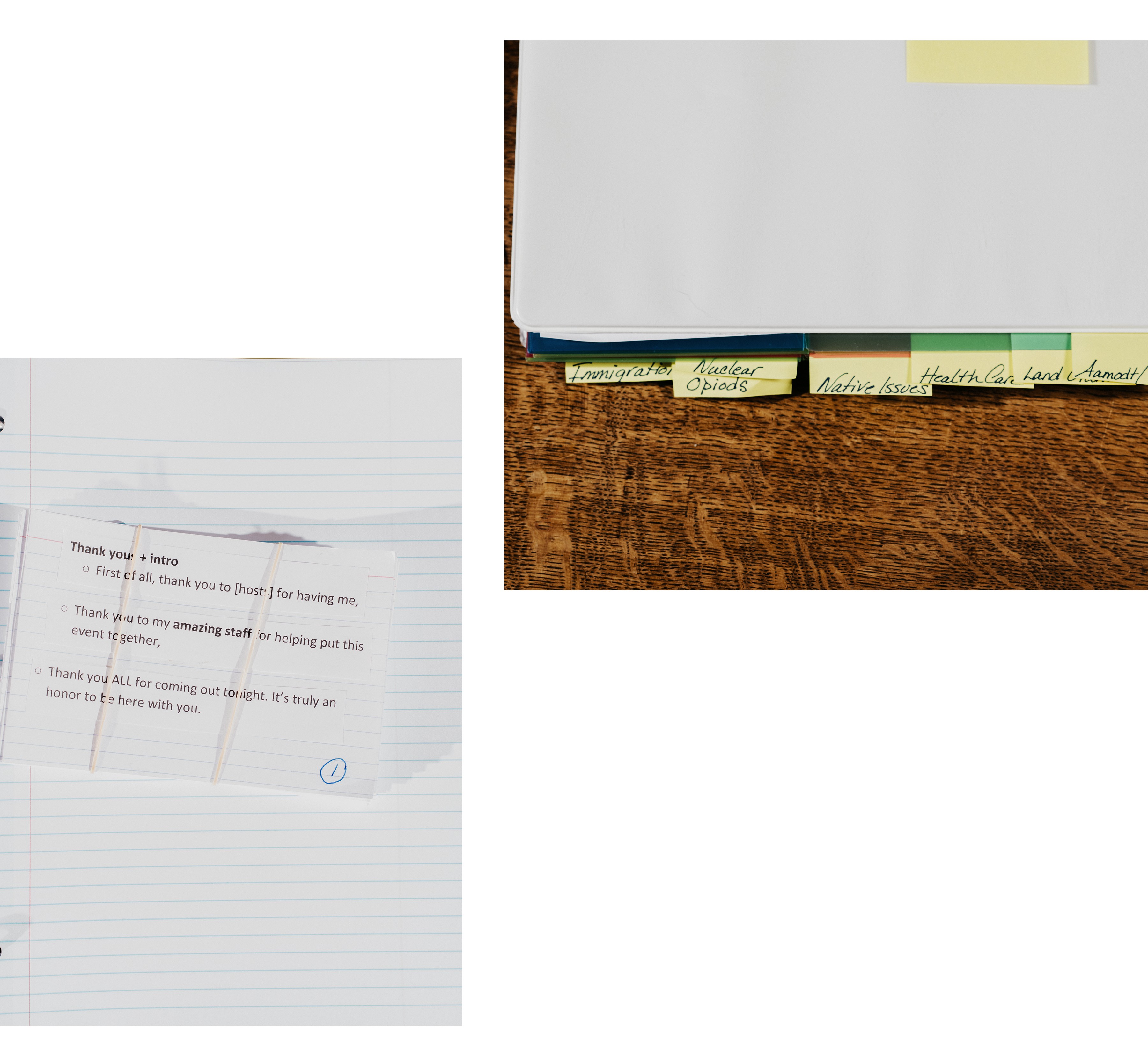 Notes for a speech that Valerie Plame was preparing for with her campaign team, and her notebook of campaign issues on her dining room table.
Notes for a speech that Valerie Plame was preparing for with her campaign team, and her notebook of campaign issues on her dining room table.
Once in residence, they donated their celebrity to the group and other progressive causes in the area, as well as elsewhere in the country, and went out on the speaker?s circuit. But by 2017, Plame?s marriage to Wilson was collapsing and the twins were about to go to college. Casting around for a next step, she organized a ?spycon? weekend in Santa Fe, inviting a dozen retired agency ex-colleagues to a two-day event to dine with spy groupies, share true stories from their covert lives in Moscow and assorted hellholes, and engage in a raucous debate about Trump and Russia. She charged more than $500 per head for the event; it was such a success that she thought about making it an annual gathering.
?It just felt like I needed to raise my hand. I wanted to serve my country again.?
Shortly after that, she decided to run for office. ?I felt compelled to run, because I believe that Donald Trump, and what is left of the Republican party, is putting the values that we care about, here in northern New Mexico, and across the country, in peril,? she says in her stump speech. ?It just felt like I needed to raise my hand. I wanted to serve my country again.?
On this pre-pandemic afternoon, Plame?s meetings are all out in the open, at a Starbucks tucked away inside a grocery store in Los Alamos, where the streets are named after nuclear bomb test sites. First up is Carl Trujillo, a recently me-too?ed (he says he was the victim of a right-wing lobbyist) ex-state legislator and engineer at Los Alamos who works on what he will only describe as ?making strong materials for our national defense.? Trujillo will try to lead Plame through the labyrinth of public and hidden interests controlling water rights in the Pojoaque basin. Tracking the years of lawsuits and layers of legislation would cause the eyes of all but the most avid hydro-bureaucrat to glaze over; Trujillo draws a flow chart of the competing lawsuits, land tracts, and interests. As the page fills up with lines and arrows and boundaries, Plame follows along attentively, peppering him with questions.
After Trujillo leaves, Plame buys herself a little package of grocery store sushi and nibbles at it while Karyl Anne Armbruster, a Los Alamos Democrat and school board member, settles in. Armbruster is a lieutenant in the unofficial army of late middle-age white female Democrats of the Trump resistance in New Mexico ? and across the nation. She is chatty, clearly proud of her exploits in the obscure reaches of the state educational bureaucracy. She likes to drop the occasional name. Plame is patient and attentive throughout. There is not a drop of the politician?s watch-checking, no hovering aide explaining that she has to be somewhere else in 30 minutes.
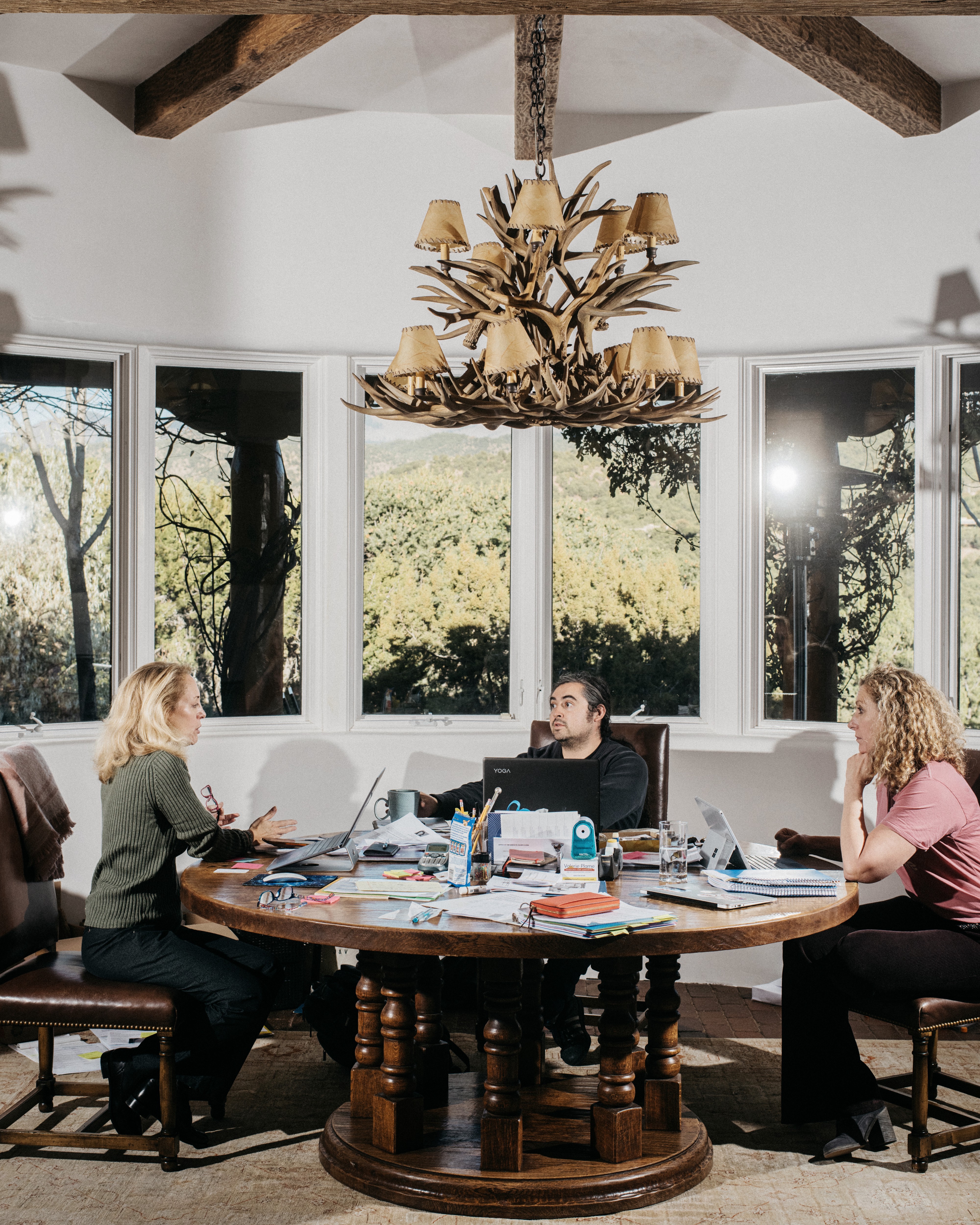 Valerie Plame, Daniel Garcia, finance director, and Michelle Barliant, campaign coordinator, work at Plame?s dining room table.
Valerie Plame, Daniel Garcia, finance director, and Michelle Barliant, campaign coordinator, work at Plame?s dining room table.
In public and often in private too, Plame comes off as patient and confident without being arrogant. Yet there remains an agent?s coolness, a poker-faced quality. It could serve her well during, say, televised congressional hearings or press conferences. Friends worry about how that preternatural chill plays on the stump.
She concedes that the cool is something of a front. ?The anxiety I feel when I wake up in the morning ? I?m like, ?Is Trump president? Has something happened???
For all her outward composure, Plame insists she?s far from immune to emotion: After the birth of her twins she suffered severe postpartum depression, which she treated with prescription drugs and therapy. The experience, she wrote later in her book, left her with ?more compassion and a drive to help out others.?
After the meetings, Plame decides to tool around the grounds of Los Alamos National Labs. We enter Stranger Things territory right away: An M-16 toting soldier in camo approaches the car window, and asks about her business in the vicinity of the lab. Plame hands him her drivers? license ? a piece of identification that?s orders of security-clearance magnitude beneath what she?d flip at guards in the bad old days of her career. He studies it, glances at her face, and waves us through, his expression suggesting no recognition.
She maneuvers the SUV past numbered ?Technical Buildings? nestled off the road in electric-fenced, Hazmat-signed plots nestled in the mesquite of the Santa Fe National Forest. A massive white satellite dish hovers above low pines on the edge of a national monument area called the Valles Caldera. The grassy bowl of a dead supervolcano, it?s the relic of an ancient geological catastrophe that stretches for miles in all directions.
The rusting hulk of what looks like a decommissioned C4 military plane squats in a clearing, part of the accumulated environmental effects of the lab on the region. Between 1943 and 1964, the lab dumped more than 30 million gallons of treated and untreated liquid radioactive and chemical waste ? tritium, strontium, plutonium, and other radioactive materials ? in two thousand sites around the 43-square mile lab property. Worries about water contamination periodically trouble the community; contaminated waste in 200 tunnels in just one sector drains directly into the area?s regional aquifer.
?All these big brains here,? she says, waving at the lab?s outbuildings. ?Imagine what they could do if applied to green energy and climate change.?
Plame wants to talk about plutonium pits. ?Pits as in olive,? she explains. The Pentagon is planning to put these devices ? the heart of a nuclear bomb ? back into production in Los Alamos in the wake of a controversial Trump administration directive reversing a post-Cold War slowdown on bomb production. Resuming production would bring money and jobs and juice the local economy. But Plame?s nonproliferation instincts are piqued.
Refocusing the labs from nukes to climate change is a quiet theme of hers. At a meet-and-greet event at a diner in Espanola, an opioid-ravaged hamlet not far from Los Alamos, Plame suggests weapons labs could be diverted to work on renewable energy. She compares the Green New Deal ? which she supports ? to JFK?s ?aspirational? moonshot politics.
?People might have laughed, but, boy you know, we kind of felt like, hey, we?re going to do this as Americans, we do hard things,? she says to a small crowd of voters who have stopped by to eat breakfast burritos and hear the candidate. ?That?s where I think the Green New Deal is.? How can we make the neighborhoods around Los Alamos communities where they are working with the Lab, on issues around renewable energy? It takes leadership and community buy-in. And that?s been absent for a long time.?
Plame is not the first aspiring politician in New Mexico to suggest pushing labs toward more peacetime projects. But so far, once in Washington, all have gone mute on the subject. The labs are a bonanza for the impoverished state. And politicians are loath to object to billions of federal dollars and a community of tens of thousands of PhDs, even if it?s all harnessed for war. Congress recently authorized $1.97 billion for Los Alamos National Labs, up from $1.89 billion in fiscal year 2019. At Los Alamos, 71% of that budget goes toward ?weapons activities? while just 2% goes to science, according to a nuclear weapons watchdog.
For decades, American progressives regarded the CIA as the source of all evil. Popular culture positioned the American intelligence agency as, at best, a gang of bloodthirsty assassins. Think Bourne Identity and Three Days of the Condor. Now, in one of those curious, only-in-America political shifts (like Republicans once being the party of science ? yes, you can look that up) the right has come to distrust ?the Deep State.? The Iraq War-era Bush administration attack on Wilson by outing Plame presaged Trump White House attacks on the spouses and lovers of such ?Deep State? actors like Andrew McCabe and Peter Strzok. And progressives in turn have embraced the CIA as an enemy of Trump.
Plame is not oblivious to the irony. ?The progressives have a lot more bogeymen to go after now, trust me, than the CIA,? she says. ?It?s not just Trump and his incessant attacks. The CIA has tried to ameliorate their image. They did a lot of really bad things, and for the most part, they learned their lesson. That whole MK-Ultra thing. Are you kidding me? The Exploding Fidel Castro cigar. What? The list of bad actions by the CIA is long. But I like to think, too, that, maybe it?s just my little fantasy, but a lot of people do understand that the CIA does a lot of things that, whether it?s counterterrorism or whether it?s counter nuclear proliferation, that, by and large most, people go, ?That?s a good thing.??
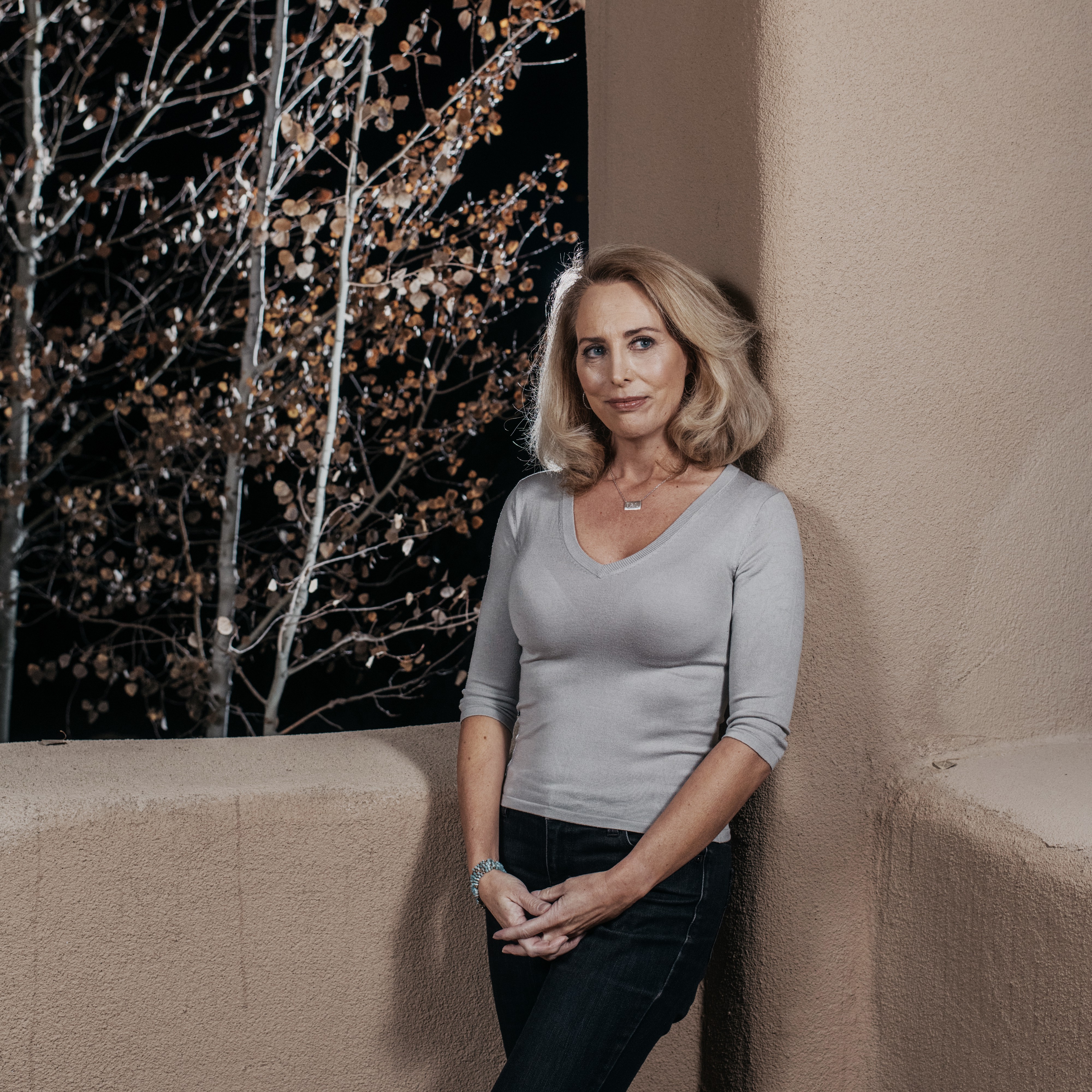
If elected, Plame would join Virginia Democrat Abigail Spanberger and Michigan Democrat Elissa Slotkin among former undercover CIA agents in Congress. The number of candidates with intelligence agency experience was high enough in 2017 that the Washington Post even saw fit to do a column on spies ?coming in from the cold? to warm themselves in the heat of Trump era politics.
Plame?s CIA background might play better in New Mexico than other states due to the weapons labs, and the state?s long, secretive atomic history. Also, well, driving backwards on a dirt road through the desert is very New Mexico. ?I think people who are highly educated will be really happy she can take that experience to Washington,? one New Mexico Democratic strategist said. ?If elected, she will be sitting in all those hearings, commenting on national security because she knows what that all looks like.? She?s also polling well with he-men. ?Men go crazy for her,? the strategist said. ?She?s an attractive well-dressed badass, but there?s something more. She is this person who took on a president, and jumped out of helicopters with guns. She has this confidence and she is aggressive and that works with the hunting and fishing types.?
The Washington Post?s Fact Checker column gave her swaggering ad three Pinocchios, because it suggests Cheney aide Scooter Libby leaked her identity, when what he was actually convicted of was lying about the affair. Her political rival Serna also questioned whether she really was posted in North Korea, Iraq, and Syria. But with her past stations still classified, no one ? certainly not her opponents ? can say for certain where she was stationed. She says she can?t talk about it at all. ?We were very careful with the choice of words in that ad,? she says. ?And what it says is, I?ve been involved in operations pertaining to these countries. I never said I lived in North Korea, for fuck?s sake. Put that in.?
Plame shoots from the lip like that, and it?s got her into trouble more than once. She shut down her Twitter account last year after she shared a link to an article headlined ?America?s Jews Are Driving America?s Wars? by a fellow former CIA officer about the power of the pro-Israel lobby. A storm of outrage ensued after readers pointed out that the author, Philip Giraldi, a longtime critic of Israeli and American activities in the Middle East, had also suggested in the piece that Jewish commentators and writers be identified as Jews. Plame first said she hadn?t read the article closely. Now, she chooses her words on the topic of Israel with great care.
?I believe that American foreign policy, the foreign policy between Israel and the United States is distorted,? she told me. ?Israel is our democratic ally, the only one in that region, and it?s really important that we continue to support them. But the Netanyahu government ? it?s a distorted relationship, is I think the best way to describe it. I?ll let someone else talk about the neocons and the lines to those that would take us to war and so forth, I?ll leave that for other people to write about.?
Plame shoots from the lip like that, and it?s got her into trouble more than once.
Candidate Plame tries to blunt the anti-Semitism charge by playing up her own blood ties to Judaism. After she was outed as a spy, and her name became national news, distant relatives reached out to her to inform her that ? unbeknownst to her, she was raised Protestant ? she had a Ukrainian rabbi among her grandparents. At a town hall event at Espanola, Plame, dressed in cowboy boots, jeans, and a white rose-embroidered cowgirl shirt she picked up at a consignment shop, had just finished an hour-long speech when the journalist Tal Schneider asked her if she was in fact a member of the Temple Beth Shalom in Santa Fe. Plame nodded her head affirmatively. But when Schneider posted the interview on YouTube, a member of the synagogue board told the Albuquerque Journal that Plame was not in fact on the official membership list.
In January 2020, Plame re-activated her Twitter account, posting a thread on how Trump would start a war against Iran based on lies and fake intelligence. ?Because we?re on the verge of another catastrophic war in the Middle East, I?m trying a restart on Twitter ? a platform I left because of its toxicity ? to add a personal view on the abuse of power by a dangerous president,? she tweeted on January 5. ?Hopefully, Twitter can still be a force for good.?
The anti-Semitism charge erupted again in the last months of the campaign, as a pro-Israel dark money group called the Alliance to Combat Extremism financed a social media ad which included a picture of Plame with swastikas superimposed on her eyes, called her ?a disgraced racist millionaire? and posed the question ?Is she running for Congress to represent New Mexicans or white supremacists?? The Washington Post tore the ad apart. ?Has there ever been an attack ad as negative as this one?? columnist Glenn Kessler wrote, giving the ad four Pinocchios.
In April, as the virus prevented Plame from further in-person stumping ? yes, even sparsely populated New Mexico has been under stay at home orders ? and as Fernandez settled into frontrunner status, Plame released another 30-second badass ad called ?Obstacle Course.? Clad in running clothes and wearing black gloves, and with a voice-over narrated by her older brother, the Vietnam vet, she runs through the desert, vaulting over poles, rappelling up a wall and crawling under barbed wire. The spot ends with a close-up on her as she grins and tries to catch her breath.?I?m Valerie Plame. And I can?t believe I approve this message,? she blurts out before turning heel and running off. The obstacle course is meant to be a facsimile of the CIA training she underwent three decades back. But it is also the perfect metaphor for her political campaign.


